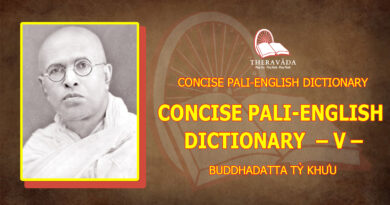A DISCOURSE ON MALUKYAPUTTA SUTTA – VIPASSANA QUESTION VI
A DISCOURSE ON MALUKYAPUTTA SUTTA – VIPASSANA QUESTION VI
“Ye te Manovinneyya dhamma avinnata avinnatapubba, na ca vijanasi, na ca ta hoti vijeneyyanti, atthi te tanha chando va rago va pemam va.”
“How do you understand this, Malukyaputta? Answer me as best you can. There are certain mind-objects, //dhamma//, which you have never apperceived previously, either in the immediate or remote past, or even at the present moment. Neither can you hope to apperceive them in the future. Can such objects arouse desire, lust and affection in you?”
As before Malukyaputta answered this in the negative, and Buddha laid down the task for him to practise insight-meditation. For a summary of what Buddha taught him, please refer to the earlier section entitled “A Brief Work-Programme”.
FAILURE TO MEDITATE ON MIND-OBJECT ON THINKING
- Dhammam natva sati muttha, Piyam nimittam manasi karoto. Sarattacitto vedeti, tanca ajjhosa titthati.
- Having thought of //dhamma//, mind-object, one loses mindfulness, and getting absorbed in the charms created by it, one feels the onset of desire that tries to imbibe it.
Here the term //dhamma// meaning mind-object, is not used in the //paramattha// or abstract sense. It relates to the six bases of eye, ear, nose, tongue, body and heart. It creates the idea of male or female. It embraces the material qualities of life and nutrition. It includes all concepts of humanity or divinity and of animals like cattle, etc. and of things like pots and pans, and of places like houses. All sense-objects, whether real or imaginary, are //dhammas//. When ordinary individuals see things that exist in nature, they recognize them by concepts as trees, forests and mountains. Those accomplished in //sammasana nana//, investigating knowledge, and //udayabbaya nana//, knowledge of arising and dissolution of conditioned things, often see in their mind’s eye visions of deities, Arahats and Buddhas, besides seeing real objects in flesh and blood. In whatever way they are seen, the individual who sees them develops attachment or repugnance in accordance with his feelings of agreeableness or disagreeableness. Once these //vedanas// arise, he becomes forgetful of the practice of meditation, virtually assimilating, or ingesting, or imbibing what he sees. Then //kilesa// arises. This is explained in the following stanza.
- Tassa vaddhunti vedana, aneka dhamma sambhava; Abhijjha ca vihesa ca, cittamassupahannati. Evam acinato dukkham, ara nibbana vuccati.
- A multitude of passions such as covetousness and rage, springing from //dhamma//, mind-object, torments him who takes a firm hold of it, with the consequence that his mind becomes burdened with vexation. Nibbana, therefore, remains far away from him who would carry the load of suffering rather than meditate.
This shows the darker side of the life of a non-meditator. There is a brighter side for the meditating yogis, and this is given in the following stanza.
- Na so rajjati dhammesu, dhammam natva patissato; Virattacitto vedeti, tanca najjhosa titthati.
- Passion remains undeveloped in him who recollects with mindfulness the //dhamma//, mind-object, that he has apperceived. Thus freed from lust, he refuses to imbibe it.
Here //dhammas//, or, in other words, //dhammarammanas//, mind-objects, are not //paramatthas// but //pannattis//. But mind-consciousness is //paramattha//. It comprises thoughts and ideas created by the mind-object. It appears, and disappears the next moment after its appearance. It is //anicca//, impermanence. When a yogi sees an object in his mind and notes it mindfully, it disappears as soon as it has been noted. What actually happens is the disappearance of mind-consciousness that constitutes //nama//. As the observer is intent upon the object, he loses sight of //citta// or //nama// created by it. As he notes it in this manner, no attachment arises in his mind. In other words, mindfulness dispels //raga//, lust or passion. In such circumstances consciousness just takes place. It does not go beyond that. This is in accordance with the statement: //Vinnatam vinnanamatta bhavissati// — When you know, let knowing be. If one fails to meditate on the mind-object, //vedana//, feeling, arises to incite //kilesa//.
- Yathassa janato dhammam, sevato capi vedanam; Khiyati nopaciyatam, evam so caratissato. Evam apacinato dukkham, santiko nibbana vuccati.
- Thinking of a mind-object, a yogi just knows it and just feels that he knows it, without assimilating //dhamma// created by it. With him suffering ceases. He should practise meditation in this way; and if he so practises it, he is said to be within sight of Nibbana.
An idea must be noted as it is formed so that inclination to //kilesa// can have no opportunity to arise. When the round of //kilesa// ceases, other rounds of kamma-actions and action-results also cease; and that particular moment of cessation of all kinds of defilements rewards the meditator with peaceful bliss; and that moment is the moment of //tadanga nibbana//.
Be it noted that Nibbana is within easy reach of everyone who practises insight-meditation. Conversely, it remains aloof from a non-meditator.
* * *
EPILOGUE
Having uttered the 24 stanzas, Buddha concluded saying;
“Imassa kho Malukyaputta maya samkhittena bhasitassa evam vittharena attho datthabbo.”
“I have, Malukyaputta, given you a very succinct account of the method of noting the sense-objects, and you must try to understand the wider meaning of it according to the 24 gathas that have now been explained.”
Rejoicing in what Buddha taught, Malukyaputta expressed his satisfaction, paid his homage to the Blessed One and departed. Then he retired to a place of solitude, applied himself with mindfulness, zeal and singleness of purpose to the practice of meditation, and, not long after, enjoyed the fruits of the sanctity of //Brahmacariya// (noble conduct), having gained insight on the spot. Now he had come face to face with Truth. For him no new becoming could arise. He had abided in the holiness of the Eightfold Noble Path, having done all there was to be done, leaving nothing undone. And all this he knew. Now our Malukyaputta had become an Arahat.
Once when Buddha was in Savatthi for his daily round for alms, he was approached by a monk by the name of Bahiya Daruciriya who insisted that the Enlightened One prescribe for him a brief religious instruction. Buddha, therefore, advised him to note seeing just as he saw, hearing just as he heard, knowing just as he knew, and thinking just as he thought in relation to sense-objects he encountered. These are his words:
“Ditthe ditthamattam bhavissati; sute sutamattam bhavissati; mute mutamattam bhavissati, vinnate vinnanamattam bhavissati.”
In this Malukyaputta Sutta, the instructions are the same. And so this method of vipassana to note with mindfulness every time the phenomena of sight, sound, odour, taste, touch and consciousness occur is far-reaching although very brief. For nearly forty years since 1300 B.E. (c. 1938 A.D.) I have been preaching this sermon for the enlightenment of thousands of devotees relating to the subjects of the Noble Path and its Fruition and of //paccavekkhana nana//, knowledge on self-examination. I believe many among them have by now come to realize knowledge that can lead them to the Path and its Fruition.
Now I shall wind up this discourse with a wish and a prayer, sharing merits we have performed in relation to charity, morality and mental development to our parents, relatives and well-wishers present here, to all humanity, to all devas and to all sentient beings in the whole universe. May they rejoice in these //kusala// wholesome actions, and gain happiness both in mind and in body!
Sadhu! Sadhu! Sadhu!









